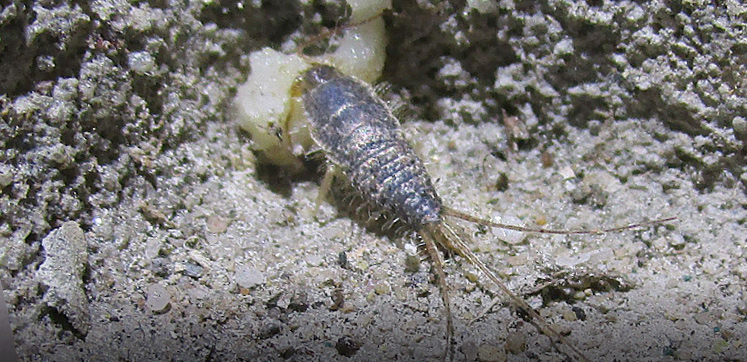
Recent years have seen a rise in silverfish infestations and they can often be hard to control due to behaviour and habitat.
Often infestations of ‘silverfish’ turn out to be infestations of the Grey silverfish or Paper fish (Ctenolepisma longicaudata) and not the Common silverfish (Lepisma saccharina). Both of these species differ in appearance. The common silverfish body is 10mm long, silvery in colour, featuring two long antennae, a tail that consists of two cerci and one terminal filament.
The Grey silverfish, on the other hand, is larger, measuring about 13-15mm, greyish in colour and with scales and tail elements that are much longer than the silverfish. Both species have differences in appearance and both species reside in different habitats. Common silverfish like an environment of around 70% relative humidity (Grey silverfish can thrive in drier conditions), and are often regarded as a nuisance to homeowners as they can start to destroy paper-based items. Because of this, the Common silverfish is mainly a problem in bathrooms, kitchens, toilets and in areas that suffer water leakages. The Grey silverfish, however, is also a guest in living rooms, public areas and storage rooms, where conditions tend to be drier.
Common silverfish can be relatively easily controlled by improving the humidity in certain locations. Improved ventilation or the repair of dripping water fittings may be enough to get rid of this species. However, these measures may not be enough for Grey silverfish, as this insect survives well in normal humidity levels. Large infestations of Grey silverfish that begin to show damage to household contents need to be controlled by a pest controller. Unfortunately, the control of Grey silverfish is not as straightforward as the control of other crawling insects such as cockroaches. This is due to the variety of habitats. Locations, where Grey silverfish live and hide, can be anywhere – floorboards, skirting boards, behind boxes, pictures, books and furniture.
To deliver a liquid application to all these different types of potential harborages is often impossible. Secondly, bait cannot be applied in the usual pattern, like that in cockroach control. Although there is evidence that both silverfish species feed on cockroach bait, they do not actively search for food like cockroaches do. It seems that silverfish can accidentally get in contact with bait and if they stumble upon it, they will feed, but they aren’t attracted to a bait spot over a distance. Besides this fact, there is only one registered bait product for controlling Common silverfish or Grey silverfish in the EU - Maxforce® Platin.
Unpon application, the absence of insects can be determined after two weeks of post bait placement. We consider this treatment method as a key element to an integrated approach to controlling this pest. To achieve the best possible outcome, a detailed inspection is needed to identify all possible hiding places, prior to setting small but frequent bait placements, followed by visits to confirm elimination or the need for bait replenishment.

Call 029 2099 0115 today to arrange a no obligation survey of your bird or pest control infestation.